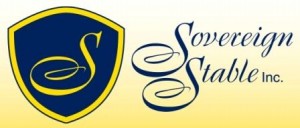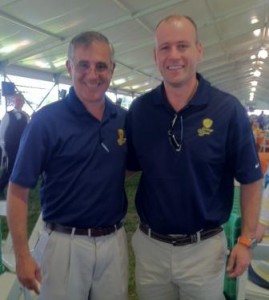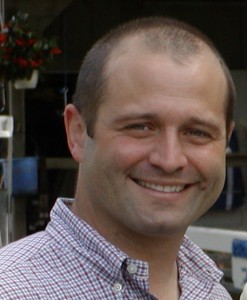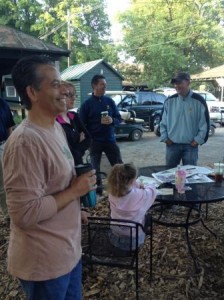Affordable Horse Ownership – The Sovereign Stable Way
So you think you might want to get involved with the ownership side of the business, but you don’t know where to start. Many of my horse racing friends are at that point. We’ve been fans of the game for decades and dreamt about standing in the winner’s circle adjacent to our winning steed. However, although we might be able to handicap a race and pick out a winner, we have absolutely no idea what it takes to make a horse a winner. And the cost, holy cow, how can the average person expect to get into a sport that is so costly?
About one year ago, one of my friends bought into a horse racing partnership at Sovereign Stable. He did his homework – contacting multiple partnerships, asking a lot of questions, researching the horses that were available at each stable. In the end, he chose Sovereign because of the “positive vibe” he got from two of the principle members of the Sovereign team, Rich Cristiano (Director of Business Development) and Matt Gatsas (President). I figured that’s as good a place as any to get started, so I recently met with Rich and Matt to discuss horse ownership – the Sovereign Stable Way.
First, let me explain the distinct roles that Rich and Matt have at Sovereign. Matt leads the effort to find horses to bring into the partnership. One way is by the purchase of 2-year olds and yearlings through auctions, and occasionally private purchases. The other way is by claiming horses out of races. After that, Rich likes to say, “My job starts when Matt’s job ends at the sales.” Rich will sit down with Matt and discuss the pedigree and then “we determine the price, minimum investment, etc. Then I do my job of selling.” That’s selling shares of the horse purchased.
Each horse purchased becomes an LLC (Limited Liability Corporation) for accounting purposes. Then Rich sells shares of the LLC in terms of a percentage. For example, my friend bought 3% of a horse and his investment was around $7,500. This was for a fairly high priced 2-year old, investments of lesser amounts are available.
One of the great things about partnerships is they can make the entry point for owners into the sport very reasonable. Rich explained, “It’s just so expensive, even for fairly wealthy people. Here in New York we base it on $50,000 a year, that’s just the maintenance alone. So, to do this on your own, or even with one or two guys is tough. So, I think you’re going to see this more. It’s really catching on here in the states.”
The $50,000 a year Rich is referring to is the annual cost of keeping a horse in training in New York. That includes training costs, veterinary, farrier, dentist (yup they need one of them), etc. So, in the case of my friend, in addition to the initial investment, he will pay an additional $1,500 a year (3% of $50,000) for the maintenance cost of keeping his horse in training.
So that’s a little of the dollars and cents. Now, regarding the ownership experience, Rich and I engaged in a detailed Q&A that appears below.
Can you describe the typical owner with Sovereign?
Different people are looking for different things out of this experience. I’ve had people who write a check, and then I never see them. Some people just want that race day experience; going to the races, being in the paddock and the winner’s circle, and getting the communication. Then there is that next group, who want to embrace the whole experience – coming out in the morning for workouts, talking with the trainer, etc. Some people find they love the mornings now more than the afternoons. I mean they still enjoy their afternoons at the track, but they savor their mornings back here.
So you must have trainers that are OK with having visitors at their barn. Can you talk about the trainers employed by Sovereign?
John Terranova was training for the Gatsas family before they started the public partnership in 2001. Last year we hired George Weaver, just to diversify a bit. It was absolutely no reflection on John, because we still have a lot of horses with John. We just wanted to offer potential investors a choice. Needless to say, our trainers have to be good horsemen and have reputations that are impeccable. Both John and George have that.
The trainer has to embrace the partnership concept. Because, guess what, there are trainers who probably don’t or couldn’t do that. In my West Point days out in California, we had a trainer who said “I can do this.” However, it just didn’t work. He couldn’t embrace the idea of engaging the clients and the partners weren’t feeling comfortable around the barn, so we ended up parting ways.
At Sovereign, we set up conference calls with the trainers, where the partners can send me their questions in advance, then we have John/George talk about all of the horses, how they’re training, etc. And the partners can listen to the conversation. We had a call before Saratoga, and John talked about the horses and I talked about the logistical side of things here (backside) in the mornings.
So a lot of your owners started out as fans or horseplayers in the game?
Yes, but something I coach people on is, you have to separate the two activities. With gambling, you handicap the race, go up to the window, bet … win or lose, then go onto the next race. Ownership is patience, patience, patience. You have to have the patience of a saint to own horses. You have a 2-year old, moving forward, moving forward, oops … you have to put the brakes on, back up now. And that happens 90% of the time. It’s amazing how fragile they are; they get a fever and you miss three weeks. So you have to have a different mentality to own. I’m not saying you can’t do both, a lot of us do. But, I’ve actually sat down with a client in the past and said you love the gambling part, but you don’t have the right mindset to own horses. So, I basically fired a client.
Ok, so how do you start off a conversation with a prospective owner?
In the first five minutes with this person, I bring up the ‘R’ word … risk. Listen, you’re not going to take out a home equity loan to do this. The analogy I use is; if you love golf, you’re going to write that check to a country club, and then you’re going to enjoy the golfing experience, you’re going to meet people, and have a good time. But, in that case you’re never ever going to get a check back from the country club. In this case you have that same mindset … you write the check, not expecting to get anything back, but there are going to be times when you are going to be pleasantly surprised when you get something back.
I close by saying that most of the time – if you’ve lost a few bucks or broke even, but had an enjoyable time … that’s a wonderful partnership. If anybody tells you something other than that, then I say they’re lying. And you will find people, who say they’ve lost money owning horses, but it was best thing they ever did, and they’re still doing it. It’s just a lot of fun.
So, if there isn’t a lot of financial incentive, what is the allure to get people interested in owning horses?
If you owned 1% of stock in the NY Yankees, you’re not going to be sitting on the bench next to Joe Giradi or talking to Derek Jeter. Here you can spend $4,000 and in the next breath you’re talking to Javier Castellano in the paddock and John Terranova or George Weaver, some of the top trainers in the game. You’re getting into the dugout. And you should see people’s eyes light up about that stuff. Then during the race; to see your horse get to the 1/8 pole and 1/16 pole with a shot to win, and of course the excitement that follows a win! To know you’re going to walk to the winner’s circle.
It started to become clear to me that the whole “racing experience” factor is a major draw for people to get involved in the ownership side of horse racing. So, I wanted to learn more about that, and in separate meetings with Rich and Matt we went further in depth in this area. I mentioned how my friend is a frequent visitor to the backside in the mornings and really seems to be the type of owner that “savors” that backside experience. And in each occasion I visited, I witnessed partners interacting with Rich and Matt in the barn area. So I asked each of them to explain their approach to engaging owners on the backside of the track.
Rich
Many of the owners want to have face time with the trainer. We tell the trainer that we’ll control the traffic for you – I mean we don’t just let them go over to the barn alone. We teach them the rules, when to engage, when not to engage … what to do with children. It’s our job to teach them that, they don’t know it through osmosis.
It’s an intimidating place to come on your own. That’s why we have the programs set up where we’re all out here, and coaching them through it. It’s a partnership, and they want to feel like they are a part of the team. I’m here at 5:45 every morning. On opening day (at Saratoga) I had 25-30 people here.
There are partnerships that will take your check, show up in the paddock and winner’s circle, and that’s it. And some partnerships are not shy about it. They’ll tell you it’s not about getting you out in the morning to have “the experience” and our trainer doesn’t want to see you. But our trainer wins races, and that’s what you need.
Having had this conversation with Rich earlier, I asked Matt about the Sovereign philosophy when it comes to encouraging owners to have that whole “racing experience.”
Matt
We tell people you should come out, it’s an enjoyable time, it’s fun. Some people take you up on it, some don’t. I mean it’s not a necessity. But, if you want that experience, we’d be happy to share it with you … and try to make it a good one. That’s the whole point. Our thought process has been … it’s such a tough game, it’s going to be a struggle to make money, what can we do to make this a good experience?
We try to make the business side the best we can, make sure everything is done right, and then share the whole experience. If they don’t, from my experience, they probably won’t stay in the game, because there is too much that can go wrong. If you’re not going to enjoy this part of it (backside), or going to the paddock, you will likely get tired of writing checks after awhile.
Back to Rich to discuss the business side of the game – to learn more about the communications between Sovereign and the partners, the options partners have, the way horses are managed, and what happens when the partnership for a particular horse comes to a close.
Tell me about partnerships in general. How does someone go about finding the right partnership for them?
You’ve got to do your research. Just like any business, there are good partnerships and bad partnerships. You just can’t assume that all of the partnerships are doing it the right way. Because, I will tell you this, to do it right, it is a labor intensive business. The communication, the background operational stuff, and the accounting alone are amazing. So, do your homework before you write that check. I want people to feel comfortable with their choice. And, I’ll put our program up against anyone out there in the business.
Can you describe some of the communication that happens between you and the partners?
When one of our horses works out, by noon I’ll have a note out to the owners with the comments about the workout. Before our horse races, we’re pretty honest with our assessment of how we think a horse is going to do in this spot, or if we think they might need a race. Like with Boston Strong, I said he might be a little short here, but he needs this race, and we’ve got to get him started. Then, after a horse has a race, when I get home, I write it up and send it out to the owners.
{I experienced this first hand, when I was with my friend at Aqueduct to see his horse make its debut. On our ride back home he received an e-mail from Rich summing up how the horse ran, what the jockey said about the race, etc. It was quite detailed and very interesting.}
On our website, the partners can log in, get information particular to them, for example K-1 statements for accounting purposes. The website is user friendly and allows me to update the communications, race notes, workout notes, offerings, etc. We have a public part and a private part of the website if I only want the partners to read about it. Like if we’re running a horse in a claiming race, I might want to tell the partners something, but don’t want to broadcast it to the public.
As a former horse owner and partner, I can put on my owner’s hat and recall the things I really liked and things that I didn’t. In my role at Sovereign, I can control some of these things in order to make the experience better for the partners.
Can you describe what happens after a horse is purchased by Matt?
We discuss pricing and what trainer will get the horse. We get some pictures and put them on the website, along with the pedigree and why we bought the horse. Then we do a formal offering. Existing clients get first dibs on buying into a new horse. Then after a week or so, we release it to our prospect list, the other 600 people or so in our database.
So you sell shares of the horse up until what point?
Until the horse goes to the gate for the first time, that’s it, no more syndication at that point. We think that’s the only fair thing to do. Some partnerships will sell the shares after a start, but we just freeze it as soon as they go to the gate the first time. Any unsold shares are owned by Sovereign at that point. For example, when Boston Strong went to the gate, Sovereign still owned 25% of the horse.
That’s the end of Part 1 of our article: Horse Ownership – The Sovereign Stable Way. Part 2 will be published soon and will contain information about “exit strategies” from a partnership, misconceptions about supplemental bills, how the partnership get compensated, how horses are acquired and managed, and Sovereign’s recent entry into the claiming game of thoroughbred horse racing. In the meantime, click here to see the Sovereign Stable website. (Caution: Their website does not work on an iPad.)
Click here to read Part 2 of the story on Horse Ownership – The Sovereign Stable Way.






4 comments on “Affordable Horse Ownership – The Sovereign Stable Way”